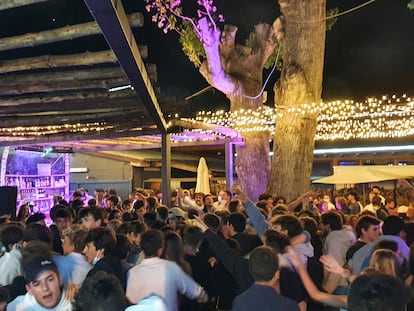Spanish health authorities support reopening of schools despite surge in coronavirus cases
According to the latest figures, more than 9,600 Covid-19 infections were reported on Thursday, the highest figure of Spain’s second wave

The Spanish Health Ministry reported on Thursday that 9,658 new coronavirus cases had been detected by the regions. This is the largest spike in infections that Spain has seen since it entered a second wave of the virus, and confirms the upward trend of Covid-19 transmission, which has been rising since the beginning of August.
The news came on the same day that Spain’s 17 regions and the Health and Education ministries met to establish protocols for how to safely reopen schools in September. According to Fernando Simón, the director of the Health Ministry’s Coordination Center for Health Alerts, students will be able to return to class even if there is “community transmission” of the virus in Spain.
Community transmission does not mean that schools cannot reopenFernando Simón, director of the Health Ministry’s Coordination Center for Health Alerts
After sternly warning last week that citizens should “have no doubts” that “things are not going well,” Simón offered a more temperate message at Thursday’s press conference. He highlighted that although some regions are seeing a noticeable rise in cases (for instance those along the Mediterranean coast) or are continuing to report very high infection numbers (mainly in Madrid), in other regions, such as Aragón, Catalonia, Basque Country and Navarre, the “trend is stabilizing or even falling.”
Simón also underscored that “the fatality [rate] is very low, around 0.4%” of all cases. The health official attributed this to the fact that Spain’s “diagnostic capability continues to increase.” For instance, last Monday – traditionally the day when fewer tests are carried out – 70,000 PCR tests were done in Spain, more than double the 30,000 that were conducted on the same day a one month ago.
Simón added that the country’s health system has not yet been overwhelmed by the rise in Covid-19 infections. While primary healthcare centers may be facing more strain in some parts of the country, due to the volume of tests and suspected cases, they were not facing “excessive” pressure, he said.
According to Simón, the situation in hospitals is “relatively calm,” although 5% of hospital beds across the country are occupied by coronavirus patients. On Thursday, the ministry reported that 6,036 people had been hospitalized with Covid-19, a rise of 133 upon Wednesday’s figure. Of this number, 715 are in intensive care, up 18 from the day before.
It is not possible to see whether hospital occupancy in each region and across Spain has risen or fallen with respect to Wednesday’s figures, as the Health Ministry did not include the decimal points in the percentages of this data point.
Simón did not expand more on the latest figures, except to say they were “similar to those from previous days,” meaning they showed a significant upward trend. The 14-day cumulative incidence of the virus has risen to 183 cases per 100,000 inhabitants, up seven from Wednesday and 41 from last week. The number of cases with symptoms beginning in the previous 14 days, a data point that had been stable and even on a downward trend, rose on Thursday and set a new record: 21,659.
Back to school
Simón made clear at the government press conference that reopening schools in September was a priority. “We have to be very clear that the goal is to open schools as long as it is feasible and with on-site teaching,” he said.
When asked about whether the high contagion rates in the Madrid region would affect the return to school, Simón replied: “It is true that Madrid has a rise in transmission that is much higher than other regions, but not in all. But it is [also] true that not every region is in the same situation and community transmission does not mean that schools cannot reopen. We have to assess the situation at every point [but] the main objective is to open them.”
Simón also had a clear message for parents reluctant about allowing their children to return to school. “Children cannot only get infected in school. It could also happen in the park, when they see their cousins, when their father is infected at work and spreads it to the family. We have to understand that children cannot be ‘bubble children’,” he said.
The health official explained that while elderly people and those with other health conditions “have a very high risk of death” from Covid-19, the virus only has a mild impact on youngsters. According to Simón, the hospitalization and fatality rate for children under the age of 10 is 1.1% and 0%, respectively. “It’s true that there could be contagions at school, but we have to assess the risks and benefits of going [to school]. I believe that right now the risks, with the measures that are being proposed, are very low. That doesn’t mean that there won’t be an outbreak [...] but the likelihood is very low,” said Simón.
English version by Melissa Kitson.
Tu suscripción se está usando en otro dispositivo
¿Quieres añadir otro usuario a tu suscripción?
Si continúas leyendo en este dispositivo, no se podrá leer en el otro.
FlechaTu suscripción se está usando en otro dispositivo y solo puedes acceder a EL PAÍS desde un dispositivo a la vez.
Si quieres compartir tu cuenta, cambia tu suscripción a la modalidad Premium, así podrás añadir otro usuario. Cada uno accederá con su propia cuenta de email, lo que os permitirá personalizar vuestra experiencia en EL PAÍS.
¿Tienes una suscripción de empresa? Accede aquí para contratar más cuentas.
En el caso de no saber quién está usando tu cuenta, te recomendamos cambiar tu contraseña aquí.
Si decides continuar compartiendo tu cuenta, este mensaje se mostrará en tu dispositivo y en el de la otra persona que está usando tu cuenta de forma indefinida, afectando a tu experiencia de lectura. Puedes consultar aquí los términos y condiciones de la suscripción digital.
More information
Últimas noticias
Most viewed
- Sinaloa Cartel war is taking its toll on Los Chapitos
- Oona Chaplin: ‘I told James Cameron that I was living in a treehouse and starting a permaculture project with a friend’
- Reinhard Genzel, Nobel laureate in physics: ‘One-minute videos will never give you the truth’
- Why the price of coffee has skyrocketed: from Brazilian plantations to specialty coffee houses
- Silver prices are going crazy: This is what’s fueling the rally










































